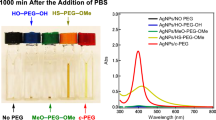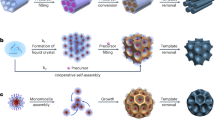Abstract
Much attention has been devoted to precise control of the size and morphology in nanosized molecular assemblies for a wide range of materials applications. Recently, we reported observing submicron/nanosized polyion complex vesicles (Nano-PICsomes) with a narrow size distribution, synthesized using specific types of homocatiomers and polyethylene glycol (PEG)-based block aniomers. However, only one example of Nano-PICsomes has been reported to date. Here, the role of the chemical composition of PEG-based block aniomers and the chemical structures of the side chains of homocatiomers were carefully examined to better understand the formation of Nano-PICsomes. Transmission electron microscopy and dynamic light scattering analyses of Nano-PICsomes revealed that a longer length of ionic segments in the block aniomers or a PEG weight fraction (fPEG) <10%, is required for the selective formation of Nano-PICsomes, whereas polymer combinations with fPEG >10% produced spherical micelles. In addition, the homocatiomers containing longer aliphatic side chains (e.g., five or six carbon atoms) favored the formation of Nano-PICsomes, whereas those containing shorter aliphatic side chains produced irregularly shaped PIC micelles. Accordingly, fPEG and the length of the side chain were found to be the key factors that control the morphologies of Nano-PICsomes. Insights gained from this study can broaden the spectrum of the design of Nano-PICsomes for use in a diverse range of material applications.
Similar content being viewed by others
Log in or create a free account to read this content
Gain free access to this article, as well as selected content from this journal and more on nature.com
or
References
Discher, B. M., Won, Y. Y., Ege, D. S., Lee, J. C-M., Bates, F. S., Discher, D. E. & Hammer, D. A. Polymersomes: tough vesicles made from diblock copolymers. Science 284, 1143–1146 (1999).
Discher, D. E. & Eisenberg, A. Polymer vesicles. Science 297, 967–973 (2002).
Yow, H. N. & Routh, A. F. Formation of liquid core-polymer shell microcapsules. Soft Matter 2, 940–949 (2006).
Anraku, Y., Kishimura, A., Oba, M., Yamasaki, Y. & Kataoka, K. Spontaneous formation of nanosized unilamellar polyion complex vesicles with tunable size and properties. J. Am. Chem. Soc. 132, 1631–1636 (2010).
Kishimura, A., Koide, A., Osada, K., Yamasaki, Y. & Kataoka, K. Encapsulation of myoglobin in PEGylated polyion complex vesicles made from a pair of oppositely charged block ionomers: a physiologically available oxygen carrier. Angew. Chem. Int. 46, 6085–6088 (2007).
Kishimura, A., Liamsuwan, S., Matsuda, H., Dong, W.-F., Osada, K., Yamasaki, Y. & Kataoka, K. pH-dependent permeability change and reversible structural transition of PEGylated polyion complex vesicles (PICsomes) in aqueous media. Soft Matter 5, 529–532 (2009).
Anraku, Y., Kishimura, A., Kobayashi, A., Oba, M. & Kataoka, K. Size-controlled long-circulating PICsome as a ruler to measure critical cut-off disposition size into normal and tumor tissues. Chem. Commun. 47, 6054–6056 (2011).
Wang, W., McConaghy, A. M., Tetley, L. & Uchegbu, I. F. Controls on polymer molecular weight may be used to control the size of palmitoyl glycol chitosan polymeric vesicles. Langmuir 17, 631–636 (2001).
Bermudez, H., Brannan, A. K., Hammer, D. A., Bates, F. S. & Discher, D. E. Molecular weight dependence of polymersome membrane structure, elasticity, and stability. Macromolecules 35, 8203–8208 (2002).
Johnston, A. P. R., Such, G. K., Ng, S. L. & Caruso, F. Challenges facing colloidal delivery systems: from synthesis to the clinic. Curr. Opin. Colloid Interface Sci. 16, 171–181 (2011).
Antonietti, M. & Forster, S. Vesicles and liposomes: a self-assembly principle beyond lipids. Adv. Mater. 15, 1323–1333 (2003).
Tanner, P., Baumann, P., Enea, R., Onaca, O., Palivan, C. & Meier, W. Polymeric vesicles: from drug carriers to nanoreactors and artificial organelles. Acc. Chem. Res. 44, 1039–1049 (2011).
Zhang, L. & Eisenberg, A. Multiple morphologies and characteristics of “crew-cut” micelle-like aggregates of polystyrene-b-poly(acrylic acid) diblock copolymers in aqueous solutions. J. Am. Chem. Soc. 118, 3168–3181 (1996).
Soo, P. L. & Eisenberg, A. Preparation of block copolymer vesicles in solution. J. Polym. Sci. Part B: Polym. Phys. 42, 923–938 (2004).
Koide, A., Kishimura, A., Osada, K., Jang, W.-D., Yamasaki, Y. & Kataoka, K. Semipermeable polymer vesicle (PICsome) self-assembled in aqueous medium from a pair of oppositely charged block copolymers: physiologically stable micro-/nanocontainers of water-soluble macromolecules. J. Am. Chem. Soc. 128, 5988–5989 (2006).
Johnson, S. M., Bangham, A. D., Hill, M. W. & Korn, E. D. Single bilayer liposomes. Biochim. Biophys. Acta. 233, 820–826 (1971).
Dong, W.-F., Kishimura, A., Anraku, Y., Sayan, C. & Kataoka, K. Monodispersed polymeric nanocapsules- spontaneous evolution and morphology transition from reducible hetero-PEG PICmicelles by controlled degradation. J. Am. Chem. Soc. 131, 3804–3805 (2009).
Blanazs, A., Armes, S. P. & Ryan, A. J. Self-assembled block copolymer aggregates: from micelles to vesicles and their biological applications. Macromol. Rapid Commun. 30, 267–277 (2009).
Anraku, Y., Kishimura, A., Yamasaki, Y. & Kataoka, K. Living unimodal growth of polyion complex vesicles via two-dimensional supramolecular polymerization. J. Am. Chem. Soc. 135, 1423–1429 (2013).
Jain, S. & Bates, F. S. On the origins of morphological complexity in block copolymer surfactants. Science 300, 460–464 (2003).
Won, Y. Y., Brannan, A. K., Davis, H. T. & Bates, F. S. Cryogenic transmission electron microscopy (cryo-TEM) of micelles and vesicles formed in water by polyethylene oxide-based block copolymers. J. Phys. Chem. B 106, 3354–3364 (2002).
Aranda-Espinoza, H., Bermudez, H., Bates, F. S. & Discher, D. E. Electromechanical limit of polymersomes. Phys. Rev. Lett. 87, 208301-1–208301-4 (2001).
Lee, J. C. M., Maria, S., Bates, F. S. & Discher, D. E. From membranes to melts, rouse to reptation: diffusion in polymersome versus lipid bilayers. Macromolecules 35, 323–326 (2002).
Won, Y. Y., Davis, H. T. & Bates, F. S. Segment distribution of the micellar brushes of poly(ethylene oxide) via small-angle neutron scattering. J. Phys. Chem. B 104, 7134–7143 (2000).
Oana, H., Morinaga, M., Kishimura, A., Kataoka, K. & Washizu, M. Direct formation of giant unilamellar vesicles from microparticles of polyion complexes and investigation of their properties using a microfluidic chamber. Soft Matter 9, 5448–5458 (2013).
Acknowledgements
This research was supported in part by a Grant-in-Aid for Scientific Research (no. 23685037 and 23106705 to A. K.) from the Ministry of Education, Culture, Sports, Science and Technology (MEXT) of Japan and by the Japan Society for the Promotion of Science (JSPS) through the ‘Funding Program for World-Leading Innovative R&D on Science and Technology (FIRST Program),’ initiated by the Council for Science and Technology Policy (CSTP). A part of this work was conducted in the Research Hub for Advanced Nano Characterization, University of Tokyo, supported by MEXT of Japan. We are grateful to Dr S. Fukuda, University of Tokyo Hospital and Mr. H. Hoshi, Research Hub for Advanced Nano Characterization at the University of Tokyo, for their valuable support in performing the TEM measurements.
Author information
Authors and Affiliations
Corresponding authors
Additional information
Supplementary Information accompanies the paper on Polymer Journal website
Supplementary information
Rights and permissions
About this article
Cite this article
Chuanoi, S., Kishimura, A., Dong, WF. et al. Structural factors directing nanosized polyion complex vesicles (Nano-PICsomes) to form a pair of block aniomer/homo catiomers: studies on the aniomer segment length and the catiomer side-chain structure. Polym J 46, 130–135 (2014). https://doi.org/10.1038/pj.2013.82
Received:
Revised:
Accepted:
Published:
Issue date:
DOI: https://doi.org/10.1038/pj.2013.82
Keywords
This article is cited by
-
Tuning the Stability of the Polyplex Nanovesicles of Oligonucleotides via a Zinc (II)-Coordinative Strategy
Chinese Journal of Polymer Science (2022)
-
Photocleavable amphiphilic diblock copolymer micelles bearing a nitrobenzene block
Colloid and Polymer Science (2016)



